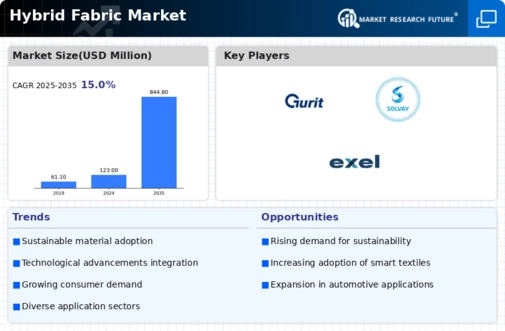Market Growth Projections
The Global Hybrid Fabric Market Industry is poised for substantial growth, with projections indicating a market value of 844.8 USD Million by 2035. This anticipated growth reflects the increasing adoption of hybrid fabrics across various sectors, driven by their unique properties and versatility. The market is expected to expand at a compound annual growth rate of 19.15% from 2025 to 2035, highlighting the potential for innovation and diversification within the industry. Such growth projections underscore the importance of hybrid fabrics in meeting the evolving needs of consumers and industries alike.
Growing Fashion Industry Trends
The Global Hybrid Fabric Market Industry is significantly influenced by evolving trends within the fashion industry. As designers increasingly prioritize functionality alongside aesthetics, hybrid fabrics are becoming a staple in contemporary fashion. The ability to combine different fibers allows for the creation of unique textures and styles that appeal to modern consumers. This trend is evident in the rising popularity of athleisure and performance wear, which often utilize hybrid fabrics for their comfort and durability. As the fashion industry continues to embrace innovation, the demand for hybrid fabrics is likely to escalate, contributing to the overall market growth.
Rising Demand for Sustainable Textiles
The Global Hybrid Fabric Market Industry experiences a notable surge in demand for sustainable textiles, driven by increasing consumer awareness regarding environmental issues. As consumers become more conscious of their purchasing decisions, manufacturers are compelled to innovate and produce eco-friendly hybrid fabrics. This trend is reflected in the projected market value of 123.0 USD Million in 2024, as brands seek to align with sustainability goals. The integration of recycled materials and organic fibers into hybrid fabrics not only enhances their appeal but also contributes to a reduction in carbon footprint, thereby fostering a more sustainable textile industry.
Expanding Applications Across Industries
The versatility of hybrid fabrics is a key driver of growth within the Global Hybrid Fabric Market Industry. These fabrics find applications across various sectors, including automotive, aerospace, and healthcare, due to their unique properties such as durability, lightweight, and resistance to environmental factors. For instance, hybrid fabrics are increasingly utilized in the automotive industry for interior components, enhancing both aesthetics and functionality. This broad applicability suggests a robust market potential, with a projected compound annual growth rate of 19.15% from 2025 to 2035, indicating a sustained interest from diverse industries.
Technological Advancements in Fabric Production
Technological advancements play a pivotal role in the evolution of the Global Hybrid Fabric Market Industry. Innovations in weaving techniques and fiber technology enable the production of high-performance hybrid fabrics that cater to diverse applications, from fashion to industrial uses. The introduction of smart textiles, which incorporate sensors and electronics, exemplifies this trend. As these technologies become more accessible, manufacturers are likely to enhance product offerings, thereby attracting a broader consumer base. This technological evolution is expected to contribute to the market's growth trajectory, with projections indicating a significant increase in market value by 2035.
Increased Investment in Research and Development
Investment in research and development is crucial for the advancement of the Global Hybrid Fabric Market Industry. Companies are allocating substantial resources to explore new materials and production methods that enhance the performance and sustainability of hybrid fabrics. This focus on innovation not only drives product differentiation but also fosters competitive advantage in a rapidly evolving market. As a result, the industry is likely to witness a proliferation of novel hybrid fabric solutions that meet the changing demands of consumers and industries alike. Such investments are expected to yield significant returns, further propelling market growth.













